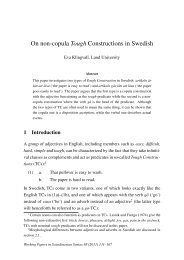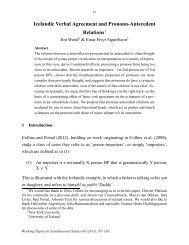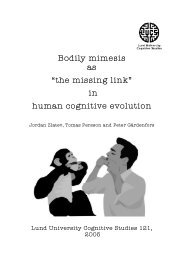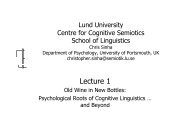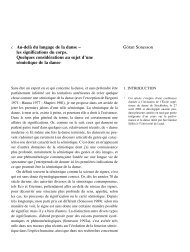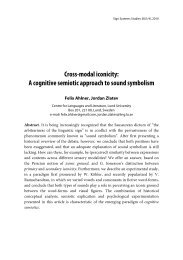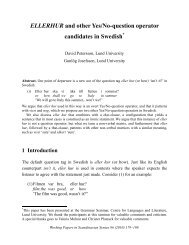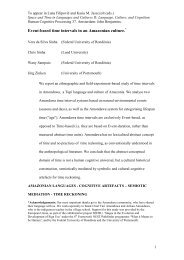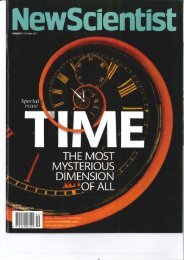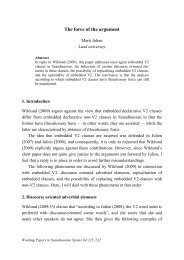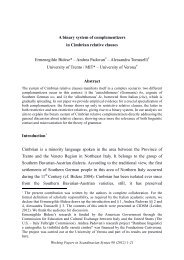Anna-Lena Wiklund In search of the force of ... - Lunds universitet
Anna-Lena Wiklund In search of the force of ... - Lunds universitet
Anna-Lena Wiklund In search of the force of ... - Lunds universitet
You also want an ePaper? Increase the reach of your titles
YUMPU automatically turns print PDFs into web optimized ePapers that Google loves.
<strong>In</strong> <strong>search</strong> <strong>of</strong> <strong>the</strong> <strong>force</strong> <strong>of</strong> dependent V2:<br />
A note on Swedish ∗<br />
<strong>Anna</strong>-<strong>Lena</strong> <strong>Wiklund</strong><br />
University <strong>of</strong> Tromsø<br />
Abstract<br />
This paper is a brief extension <strong>of</strong> recent work on embedded verb second and<br />
is a contribution to re<strong>search</strong> on <strong>the</strong> relation between V2 and illocutionary<br />
<strong>force</strong>. It presents a problem for <strong>the</strong> hypo<strong>the</strong>sis that <strong>the</strong>re is an illocutionary<br />
motivation for <strong>the</strong> verb second word order in Mainland Scandinavian declaratives.<br />
The relevant <strong>force</strong>, to <strong>the</strong> extent that we can identify it, appears to be<br />
available also in <strong>the</strong> absence <strong>of</strong> V2 word order.<br />
1 <strong>In</strong>troduction<br />
The background <strong>of</strong> this paper is a wish to understand <strong>the</strong> alleged semantic<br />
difference between <strong>the</strong> two members <strong>of</strong> minimal pairs like (1) in view <strong>of</strong><br />
hypo<strong>the</strong>sis (2).<br />
(1) a. Olle sa att han inte hade läst boken.<br />
Olle say.Past that he not had read.Sup book.Def<br />
b. Olle sa att han hade inte läst boken<br />
Olle say.Past that he had not read.Sup book.Def<br />
‘Olle said that he had not read <strong>the</strong> book.’<br />
(2) Illocution hypo<strong>the</strong>sis <strong>of</strong> V2 (declaratives):<br />
(non-V2)<br />
(V2)<br />
V2 declaratives have illocutionary <strong>force</strong>, V-in-situ declaratives don’t.<br />
Example (1a) shows <strong>the</strong> more common non-V2 word order in Mainland<br />
Scandinavian embedded clauses, (1b) embedded verb second. The ques-<br />
tion is whe<strong>the</strong>r it is possible to identify an illocutionary <strong>force</strong> in (1b) that is<br />
∗ I wish to thank Kristine Bentzen, Björn Lundquist, Christer Platzack, and <strong>the</strong> participants at<br />
Grammatikseminariet, Göteborgs Universitet (April 24, 2009) for discussion.<br />
Working Papers in Scandinavian Syntax 83 (2009), 27–36.
28<br />
absent in (1a), in which case <strong>the</strong> V2 word order (V-in-C) would be a poten-<br />
tial <strong>force</strong> marker. A related question is whe<strong>the</strong>r this <strong>force</strong> is never present<br />
in V-in-situ declaratives, in which case <strong>the</strong> <strong>force</strong> perceived would actually<br />
be dependent on V2 word order, in support <strong>of</strong> (2).<br />
Recent re<strong>search</strong> on embedded verb second in Scandinavian declarative<br />
clauses divide in two camps regarding (2) with <strong>the</strong> more optimistic Julien<br />
(2007) on <strong>the</strong> one side and <strong>the</strong> more sceptical <strong>Wiklund</strong> et al. (2009) on <strong>the</strong><br />
o<strong>the</strong>r. The debate bears some resemblance to that represented in Theoret-<br />
ical Linguistics 32-3 (2006) between Truckenbrodt (2006) and e.g. Reis<br />
(2006) on <strong>the</strong> semantic motivation <strong>of</strong> verb movement to C i German. O<strong>the</strong>r<br />
works on <strong>the</strong> relation between illocutionary <strong>force</strong> and V2 include Ander-<br />
sson (1975), den Besten (1977/1983), Wechsler (1991), Heycock (2006)<br />
and Julien (2007).<br />
V2 is one <strong>of</strong> many phenomena that call for scrutiny if we are to choose<br />
between models where illocutionary <strong>force</strong> is not directly encoded in syn-<br />
tax (even though it can be traced to syntactic properties), as in Zanuttini<br />
and Portner (2003), and models where syntax takes over a great deal <strong>of</strong><br />
<strong>the</strong> burden <strong>of</strong> pragmatics, as in Speas and Tenny (2003). <strong>In</strong> <strong>the</strong> latter, sen-<br />
tence mood and point <strong>of</strong> view related phenomena are taken to be deducible<br />
from a layered speech act phrase and a layered sentience phrase, respec-<br />
tively. The issues raised here do not put into question <strong>the</strong> presence <strong>of</strong> a<br />
Force head as such, <strong>the</strong> primary role <strong>of</strong> which is to distinguish clause types<br />
(Rizzi 1997). This head may be layered and perhaps does also encode illo-<br />
cutionary <strong>force</strong>. However while sympa<strong>the</strong>tic to <strong>the</strong> cartographic <strong>the</strong>ory in<br />
general, I think <strong>the</strong>re is room for some scepticism until it has been shown<br />
that illocutionary <strong>force</strong> does not follow from o<strong>the</strong>r properties. 1 This note<br />
is a contribution to re<strong>search</strong> on <strong>the</strong> relation between V2 and illocutionary<br />
<strong>force</strong>. I will end up not having much to say about whe<strong>the</strong>r or not <strong>the</strong>re is<br />
1 For cartographic approaches, see Rizzi (1997) on <strong>the</strong> C-domain, Cinque (1999) on <strong>the</strong> I-domain, Ramchand<br />
(2008) on <strong>the</strong> V-domain <strong>of</strong> <strong>the</strong> clause, and works under <strong>the</strong> heading <strong>of</strong> Nanosyntax that take <strong>the</strong> “atoms” <strong>of</strong><br />
syntax to be smaller than words or morphemes (to which <strong>the</strong> work by Ramchand 2008 also belongs).
29<br />
a <strong>force</strong> in (1b). However, to <strong>the</strong> extent that we can identify such a <strong>force</strong>, it<br />
also appears to be available in V-in-situ declaratives. This weakens <strong>the</strong> re-<br />
lation between V2 and illocutionary <strong>force</strong> even though <strong>the</strong>re is little doubt<br />
about <strong>the</strong>re being a relation (at least in Mainland Scandinavian), if by noth-<br />
ing else, by virtue <strong>of</strong> both being root phenomena.<br />
2 Embedded V2 is limited to asserted clauses<br />
The illocutionary act normally associated with declaratives is that <strong>of</strong> as-<br />
serting, roughly <strong>the</strong> act <strong>of</strong> uttering a sentence with <strong>the</strong> intention to make<br />
<strong>the</strong> addressee accept <strong>the</strong> content <strong>of</strong> it and take it as part <strong>of</strong> <strong>the</strong> common<br />
ground. Given that <strong>the</strong> verb second word order in Swedish and o<strong>the</strong>r lan-<br />
guages is excluded under <strong>the</strong> factive predicate ångra (≈‘regret’), see (3a),<br />
where <strong>the</strong> content <strong>of</strong> <strong>the</strong> clause is presupposed (already part <strong>of</strong> <strong>the</strong> com-<br />
mon ground), we seem to have support in favor <strong>of</strong> <strong>the</strong>re being a relation<br />
between <strong>the</strong> verb second word order and assertion or <strong>the</strong> corresponding<br />
assertoric <strong>force</strong>. We can at least conclude that a presupposed proposition<br />
cannot be expressed by using <strong>the</strong> verb second word order.<br />
(3) a. *Olle ångrade att han hade inte läst boken.<br />
Olle regret.Past that he had not read.Sup book.Def<br />
b. Olle ångrade att han inte hade läst boken<br />
Håkan regret.Past that he not had read.Sup book.Def<br />
‘Olle regretted that he had not read <strong>the</strong> book.’<br />
Looking at semi-factives like upptäcka ‘discover’, we see two things. First,<br />
factivity is irrelevant to V2 but whe<strong>the</strong>r <strong>the</strong> content <strong>of</strong> <strong>the</strong> embedded clause<br />
is presupposed by both <strong>the</strong> speaker and <strong>the</strong> hearer or only by <strong>the</strong> speaker<br />
appears to be relevant for <strong>the</strong> possibility <strong>of</strong> verb second (see <strong>Wiklund</strong> et al.<br />
2009 for details).
(4) Olle upptäckte inte att <strong>Lena</strong> hade redan gått.<br />
Olle discover.Past not that <strong>Lena</strong> had already go.Sup<br />
‘Olle did not discover that <strong>Lena</strong> had already left.’<br />
30<br />
<strong>In</strong> (4), <strong>the</strong> content <strong>of</strong> <strong>the</strong> embedded proposition has to be presupposed by<br />
<strong>the</strong> speaker but need not be so by <strong>the</strong> hearer, in which case <strong>the</strong> illocution <strong>of</strong><br />
<strong>the</strong> clause potentially qualifies as an assertion; <strong>the</strong> sentence may be uttered<br />
with <strong>the</strong> intention <strong>of</strong> informing <strong>the</strong> adressee about <strong>the</strong> fact that <strong>Lena</strong> had<br />
already left. To <strong>the</strong> extent that we want to accept calling something that is<br />
presupposed asserted in this context, which is a matter <strong>of</strong> terminology, we<br />
can at least conclude that <strong>the</strong> less presupposed <strong>the</strong> content <strong>of</strong> <strong>the</strong> clause<br />
is, <strong>the</strong> more compatible it is with verb second. (4) contrasts with (3b) in<br />
precisely this way. <strong>In</strong> (3b), <strong>the</strong> content <strong>of</strong> <strong>the</strong> embedded clause has to be<br />
part <strong>of</strong> <strong>the</strong> common ground (presupposed by both speaker and hearer).<br />
A third discovery is <strong>the</strong> compatibility between verb second and matrix<br />
negation in Scandinavian under semi-factive verbs, as in (4). 2 This is in fact<br />
also possible with say as long as negation is not an illocutionary negation<br />
(in <strong>the</strong> sense <strong>of</strong> Searle and Vanderveken 1985). The negation <strong>of</strong> a non-<br />
assertive verb like doubt shows <strong>the</strong> same (marginal) compatibility, (5a),<br />
here despite <strong>the</strong> fact that this verb is o<strong>the</strong>rwise not compatible with <strong>the</strong><br />
verb second word order, cf. (5b).<br />
(5) a. ?Jag<br />
I<br />
b. *Jag<br />
I<br />
tvivlar inte på att den boken köper du.<br />
doubt.Pres not on that DET book.Def buy.Pres you<br />
tvivlar på att den boken köper du.<br />
doubt.Pres on that DET book.Def buy.Pres you<br />
All <strong>of</strong> <strong>the</strong>se facts show us that <strong>the</strong>re is a relation between verb second<br />
word order in declaratives and assertion in <strong>the</strong> sense that V2 word order is<br />
ruled out in cases where <strong>the</strong> speaker is not undertaking some commitment<br />
to <strong>the</strong> proposition expressed, as in (5b), and in cases where <strong>the</strong>re is no<br />
2 Ano<strong>the</strong>r verb with <strong>the</strong> same properties, which is factive when embedding a finite clause (but does not belong<br />
to <strong>the</strong> semi-factives) is glömma ‘forget’.
31<br />
wish to update <strong>the</strong> common ground (to inform <strong>the</strong> hearer <strong>of</strong> something),<br />
as in cases where <strong>the</strong> embedded proposition is already part <strong>of</strong> <strong>the</strong> common<br />
ground, (3a).<br />
3 V-in-situ declaratives<br />
One immediate problem, however, is that <strong>the</strong> non-V2 word order is <strong>the</strong> de-<br />
fault word order <strong>of</strong> Swedish embedded clauses and it is not clear in what<br />
sense <strong>the</strong> non-V2 word order under say, (1a), and discover on <strong>the</strong> relevant<br />
use, (6), are not also assertions (again, to <strong>the</strong> extent that we wish to label in-<br />
formative presuppositions assertions); at least (6) yields <strong>the</strong> interpretation<br />
<strong>of</strong> a commitment to <strong>the</strong> embedded proposition on <strong>the</strong> part <strong>of</strong> <strong>the</strong> speaker<br />
and on <strong>the</strong> paren<strong>the</strong>tical use we can also infer a wish that <strong>the</strong> embedded<br />
proposition is added to <strong>the</strong> common ground (also becomes known to <strong>the</strong><br />
addressee).<br />
(6) Olle upptäckte att <strong>Lena</strong> inte hade gått.<br />
Olle discover.Past that <strong>Lena</strong> not had go.Sup<br />
‘Olle did not discover that <strong>Lena</strong> had not left.’<br />
(4) and (6) both seem to have paren<strong>the</strong>tical uses, just like (1a) and (1b).<br />
Note that <strong>the</strong>re seems to be no way to distinguish <strong>the</strong> two word orders<br />
in terms <strong>of</strong> notions like main assertion (Hooper and Thompson 1973). <strong>In</strong><br />
<strong>Wiklund</strong> et al. (2009), a detailed investigation <strong>of</strong> Icelandic, Norwegian, and<br />
Swedish is performed, using <strong>the</strong> diagnostics presented in Simons (2007) in<br />
<strong>search</strong> for differences between <strong>the</strong> two word orders regarding <strong>the</strong> status <strong>of</strong><br />
<strong>the</strong> clause in terms <strong>of</strong> main assertion (Main Point <strong>of</strong> Utterance – MPU in<br />
<strong>the</strong> terminology <strong>of</strong> Simons 2007). Whenever <strong>the</strong> content <strong>of</strong> an embedded<br />
clause alone can constitute <strong>the</strong> answer to a question, <strong>the</strong> embedded clause<br />
has <strong>the</strong> possibility <strong>of</strong> being <strong>the</strong> MPU. It is shown that nei<strong>the</strong>r is <strong>the</strong> V2<br />
word order necessary for a clause to represent <strong>the</strong> main assertion, nor is<br />
this word order unambiguously <strong>the</strong> main assertion <strong>of</strong> <strong>the</strong> sentence. As an
32<br />
illustration, <strong>the</strong> example sentences in (8) and (9) are all possible answers to<br />
<strong>the</strong> question in (7). <strong>In</strong> (8), <strong>the</strong> embedded clause expresses <strong>the</strong> main asser-<br />
tion (he did not come to <strong>the</strong> party because he did not have time), in (9) <strong>the</strong><br />
whole sentence represents <strong>the</strong> main assertion (he did not come to <strong>the</strong> party<br />
because someone said something that <strong>of</strong>fended him). Under both uses, <strong>the</strong><br />
non-V2 word order (a-sentences) and <strong>the</strong> V2 word order (b-sentences) are<br />
both possible.<br />
(7) Varför kom han inte på festen?<br />
why come.Past he not to party<br />
‘Why didn’t he come to <strong>the</strong> party.’<br />
(8) a. Han<br />
he<br />
påstod att han inte hade tid.<br />
claim.Past that he not had time<br />
b. Han påstod att han hade inte tid.<br />
he claim.Past that he had not time<br />
‘He claimed that he did not have time.’<br />
(9) a. Någon sa att dom inte ville ha en idiot där.<br />
someone say.Past that <strong>the</strong>y not want.Past have an idiot <strong>the</strong>re<br />
b. Någon sa att dom ville inte ha en idiot där.<br />
someone say.Past that <strong>the</strong>y want.Past not an idiot <strong>the</strong>re<br />
‘Someone said that <strong>the</strong>y didn’t want an idiot <strong>the</strong>re.’<br />
MPU-readings, just like <strong>the</strong> V2 word order, are not possible when <strong>the</strong> con-<br />
tent is already part <strong>of</strong> <strong>the</strong> common ground, nor under non-assertive pred-<br />
icates (e.g. doubt). Under assertive predicates and semi-factives, however,<br />
MPU-readings are possible, just like <strong>the</strong> V2 word order, see <strong>Wiklund</strong> et al.<br />
(2009) for details. Importantly though, <strong>the</strong> non-V2 word order is also pos-<br />
sible.
4 Identifying <strong>force</strong><br />
33<br />
Suppose that <strong>the</strong> relevant clauses with non-V2 word order never<strong>the</strong>less<br />
lack <strong>the</strong> <strong>force</strong> <strong>of</strong> an assertion. The question is how to identify that <strong>force</strong>.<br />
Assertive particles, speech act adverbials, and swear words would seem<br />
to constitute candidate indicators. However, <strong>the</strong>se elements appear per-<br />
fectly fine also with <strong>the</strong> non-V2 word order, see (10). 3 According to Julien<br />
(2008), <strong>the</strong> V2 word order is preferred with discourse-oriented swear words.<br />
Many speakers (including myself), however, do not agree with this intu-<br />
ition.<br />
(10) a. Hon<br />
she<br />
b. Hon<br />
she<br />
c. Hon<br />
she<br />
upptäckte att han ju inte hade rest.<br />
discover.Past that he you-know not had go.Sup<br />
sa att han fasen inte hade gjort ett skit.<br />
say.Past that he SwearWrd not had do.Sup a shit<br />
sa att han ärligt talat inte hade betalat.<br />
say.Past that he honestly speaking not had pay.Sup<br />
d. Vi upptäckte att de nämligen/minsann inte hade kommit.<br />
we discover.Past that <strong>the</strong>y you-see/indeed not had come.Sup<br />
Although this fact does not preclude a difference between V2 and non-V2<br />
word order with respect to illocutionary <strong>force</strong> in <strong>the</strong> absence <strong>of</strong> <strong>the</strong> above<br />
elements, verb movement does not appear to be obligatory in <strong>the</strong> presence<br />
<strong>of</strong> <strong>the</strong> purported illocutionary <strong>force</strong> features. Note also that <strong>the</strong> above ele-<br />
ments are impossible in precisely those environments where MPU readings<br />
are unavailable and where V2 word order is impossible in Swedish:<br />
(11) a. Hon<br />
she<br />
ångrade att hon (*ju) inte hade rest.<br />
regret.Past that he you-know not had go.Sup<br />
3 The same seems to be true for Norwegian (Kristine Bentzen, p.c.).
. Hon<br />
she<br />
skit.<br />
shit<br />
tvivlade<br />
doubt.Past<br />
på<br />
on<br />
att<br />
that<br />
34<br />
han<br />
he<br />
(*fasen)<br />
SwearWrd<br />
inte<br />
not<br />
hade<br />
had<br />
gjort<br />
do.Sup<br />
If illocutionary <strong>force</strong> is possible in <strong>the</strong> absence <strong>of</strong> V2 word order, this<br />
weakens <strong>the</strong> connection between V2 and illocution considerably. The im-<br />
portant observation seems to be that <strong>the</strong> three phenomena V2, Main-Point-<br />
<strong>of</strong>-Utterance readings, and illocutionary <strong>force</strong> (qua identifiable by <strong>the</strong> above<br />
mentioned elements) may occur independently from one ano<strong>the</strong>r. Unless<br />
we have evidence to <strong>the</strong> contrary, illocutionary <strong>force</strong> may be derived from<br />
whatever is responsible for <strong>the</strong> root status <strong>of</strong> a clause, which in depen-<br />
dent clauses may be e.g. <strong>the</strong> presence <strong>of</strong> a certain layer <strong>of</strong> <strong>the</strong> C-domain in<br />
combination with o<strong>the</strong>r configurational properties. E.g. V2-clauses appear<br />
to contrast with clauses displaying non-V2 word order in not being topi-<br />
calizable, (12a) vs. (12b). This is also true <strong>of</strong> <strong>the</strong> embedded clauses in (10)<br />
that lack V2 word order but involve discourse elements, cf. (12c). 4<br />
(12) a. Att hon inte<br />
that she<br />
igår.<br />
yesterday<br />
not<br />
b. *Att hon hade<br />
that she had<br />
igår.<br />
yesterday<br />
hade<br />
had<br />
inte<br />
not<br />
gått<br />
go.Sup<br />
gått<br />
go.Sup<br />
hem<br />
home<br />
hem<br />
home<br />
upptäckte<br />
discover.Past<br />
upptäckte<br />
discover.Past<br />
han<br />
he<br />
han<br />
he<br />
ett<br />
a<br />
först<br />
not-until<br />
först<br />
not-until<br />
4 Ano<strong>the</strong>r property that seems to show <strong>the</strong> same distributional split is <strong>the</strong> obligatoriness <strong>of</strong> (or preference to<br />
insert) <strong>the</strong> complementizer in V2-clauses and clauses involving <strong>the</strong> above mentioned discourse elements (I<br />
am indebted to Christer Platzack for reminding me <strong>of</strong> this fact):<br />
(i) a. Hon sa (att) hon inte hade läst den.<br />
she say.Past that she had read.Sup it<br />
b. Hon sa ??(att) hon hade inte läst den.<br />
she say.Past that she had not read.Sup it<br />
c. Hon sa ??(att) hon nämligen inte hade läst den.<br />
she say.Past that she you.see not had read.Sup it
35<br />
c. *Att hon nämligen hade gått hem upptäckte han först<br />
that she you-see<br />
igår.<br />
yesterday<br />
had go.Sup home discover.Past he not-until<br />
As a final note, V-in-situ is in fact possible also in root clauses; in excla-<br />
matives <strong>of</strong> <strong>the</strong> kind shown in (13a). <strong>In</strong> <strong>the</strong>se, a <strong>force</strong> is arguably present<br />
(exclamative) but V2 word order is impossible, cf. (13b).<br />
(13) a. Att han inte var där!<br />
that he not was <strong>the</strong>re<br />
b. *Att han var inte där!<br />
that he was not <strong>the</strong>re<br />
Although this fact says nothing about <strong>the</strong> relation between V2 and <strong>the</strong> spe-<br />
cific illocutionary <strong>force</strong> <strong>of</strong> assertion (see Truckenbrodt 2006 on <strong>the</strong> differ-<br />
ence between exclamatives and epistemic speech acts), it is ano<strong>the</strong>r case<br />
where V-in-situ appears to come with illocutionary <strong>force</strong>. Examples <strong>of</strong><br />
what appears to be <strong>the</strong> reverse situation – V2 without illocutionary <strong>force</strong><br />
– can be found in Icelandic A (see Jónsson 1996 and also Gärtner 2003),<br />
where V2 word order is possible also under non-assertive and factive pred-<br />
icates. 5 Thus, verb second does not always yield <strong>force</strong> and <strong>force</strong> does not<br />
appear to require verb second, not even <strong>the</strong> <strong>force</strong>s associated with epis-<br />
temic speech acts.<br />
5 Conclusion<br />
I have discussed problems for <strong>the</strong> hypo<strong>the</strong>sis that <strong>the</strong>re is an illocutionary<br />
motivation for <strong>the</strong> verb second word order. The relevant <strong>force</strong>, to <strong>the</strong> extent<br />
that we can identify it, appears to be available also in <strong>the</strong> absence <strong>of</strong> V2<br />
word order in Swedish.<br />
5 See <strong>Wiklund</strong> et al. 2007 and <strong>Wiklund</strong> et al. 2009 for arguments in favor <strong>of</strong> taking all Icelandic verb move-<br />
ment to be to C.
References<br />
36<br />
Andersson, Lars-Gunnar. 1975. Form and function <strong>of</strong> subordinate clauses. Doctoral Dissertation, Go<strong>the</strong>nburg<br />
University.<br />
Cinque, Guglielmo. 1999. Adverbs and functional heads - a crosslinguistic perspective. Oxford: Oxford<br />
University Press.<br />
den Besten, Hans. 1977/1983. On <strong>the</strong> interaction <strong>of</strong> root transformations and lexical deletive rules. <strong>In</strong> On<br />
<strong>the</strong> formal syntax <strong>of</strong> <strong>the</strong> Westgermania, ed. Werner Abraham, 47–131. Amsterdam: John Benjamins.<br />
Gärtner, Hans-Martin. 2003. How Icelandic can you be if you speak Icelandic B. <strong>In</strong> Grammar in Fokus:<br />
Festschrift for Christer Platzack 18 november 2003, ed. L-O. Delsing, C. Falk, G. Josefsson, and H. Á.<br />
Sigurðsson, 115–122. Lund: <strong>In</strong>stitutionen för nordiska språk, <strong>Lunds</strong> Universitet.<br />
Heycock, Caroline. 2006. Embedded root phenomena. <strong>In</strong> The Blackwell Companion to Syntax, ed. M. Everaert<br />
and H. van Riemsdijk, volume II, 174–209. Oxford: Blackwell.<br />
Hooper, Joan, and Sandra Thompson. 1973. On <strong>the</strong> applicability <strong>of</strong> root transformations. Linguistic <strong>In</strong>quiry<br />
4:465–497.<br />
Julien, Marit. 2007. Embedded V2 in Norwegian and Swedish. Working Papers in Scandinavian Syntax<br />
80:103–161.<br />
Julien, Marit. 2008. On embedded V2 in Mainland Scandinavian. Talk given at <strong>the</strong> NORMS workshop on<br />
Root phenomena and <strong>the</strong> Left Leriphery, Tromsø, May 20 2008.<br />
Jónsson, Jóhannes Gísli. 1996. Clausal architecture and Case in Icelandic. Doctoral Dissertation, University<br />
<strong>of</strong> Massachusetts at Amherst.<br />
Ramchand, Gillian C. 2008. Verb meaning and <strong>the</strong> lexicon: A first Phase Syntax. Cambridge: Cambridge<br />
University Press.<br />
Reis, Marga. 2006. Is German V-to-C movement really semantically motivated? Some empirical problems.<br />
Theoretical Linguistics 32:369–380.<br />
Rizzi, Luigi. 1997. The fine structure <strong>of</strong> <strong>the</strong> left periphery. <strong>In</strong> Elements <strong>of</strong> Grammar: Handbook in Generative<br />
Syntax, ed. L. Haegeman, 281–337. Dordrecht: Kluwer.<br />
Searle, J., and D. Vanderveken. 1985. Foundations <strong>of</strong> Illocutionary logic. Cambridge: Cambridge University<br />
Press.<br />
Simons, Mandy. 2007. Observations on embedding verbs, evidentiality, and presupposition. Lingua<br />
117:1034–1056.<br />
Speas, Peggy, and Carol Tenny. 2003. Configurational properties <strong>of</strong> point <strong>of</strong> view roles. <strong>In</strong> Asymmetry in<br />
Grammar, ed. <strong>Anna</strong> Maria Di Sciullo, 315-344. John Benjamins.<br />
Truckenbrodt, Hubert. 2006. On <strong>the</strong> semantic motivation <strong>of</strong> syntactic verb movement to C in German.<br />
Theoretical Linguistics 32:257–306.<br />
Wechsler, Stephen. 1991. Verb second and illocutionary <strong>force</strong>. <strong>In</strong> Views on phrase structure, ed. Ka<strong>the</strong>rine<br />
Leffel and Denis Bouchard, 177–191. Dordrecht: Kluwer.<br />
<strong>Wiklund</strong>, <strong>Anna</strong>-<strong>Lena</strong>, Kristine Bentzen, Gunnar Hrafn Hrafnbjargarson, and Þorbjörg Hróarsdóttir.<br />
2009. On <strong>the</strong> distribution and illocution <strong>of</strong> V2 in Scandinavian that-clauses. Lingua URL<br />
doi:10.1016/j.lingua.2009.03.006.<br />
<strong>Wiklund</strong>, <strong>Anna</strong>-<strong>Lena</strong>, Gunnar Hrafn Hrafnbjargarson, Kristine Bentzen, and Þorbjörg Hróarsdóttir. 2007.<br />
Rethinking Scandinavian verb movement. Journal <strong>of</strong> Comparative Germanic Linguistics 10:203–233.<br />
Zanuttini, Raffaella, and Paul Portner. 2003. Exclamative clauses: At <strong>the</strong> syntax-semantics interface. Language<br />
79:39–81.<br />
<strong>Anna</strong>-<strong>Lena</strong> <strong>Wiklund</strong> (anna-lena.wiklund@uit.no)<br />
Department <strong>of</strong> Language and Linguistics/CASTL<br />
Faculty <strong>of</strong> Humanities<br />
University <strong>of</strong> Tromsø<br />
N-9037 Tromsø, NORWAY



